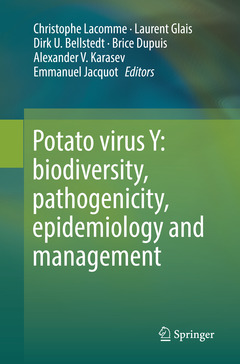Description
Potato virus Y: biodiversity, pathogenicity, epidemiology and management, 1st ed. 2017
Coordinators: Lacomme Christophe, Glais Laurent, Bellstedt Dirk U., Dupuis Brice, Karasev Alexander V., Jacquot Emmanuel
Language: English
Subjects for Potato virus Y: biodiversity, pathogenicity...:
Keywords
Diagnostic; Epidemiology; Evolution; Pathogenicity; Virology
Publication date: 06-2018
Support: Print on demand
Publication date: 08-2017
261 p. · 15.5x23.5 cm · Hardback
Description
/li>Contents
/li>Biography
/li>Comment
/li>
Potato virus Y (PVY) infects a wide host range mainly within the Solanaceae and is distributed worldwide. PVY is transmitted by more than 40 aphid species in a non persistent manner. Isolates of the PVY species are highly variable at biological, serological and molecular levels. Epidemiological studies have highlighted the emergence of distinct potato PVY variants able to induce necroses on potato tubers. Due to the lack of efficient resistance to PVY isolates inducing necrotic symptoms in cultivated varieties and the plant-to-plant transmission of isolates through the daughter tubers, PVY has become the most economically important virus for the potato industry. The review offers an overview of several decades of research on PVY but also focuses on the latest data obtained by expert on PVY worldwide on the biological characteristics of PVY, interactions between aphids-hosts, its evolution and management. Identified knowledge gaps to understand further PVY biology will be discussed.
1. 1. General Characteristics of Potato virus Y (PVY) and its Impact on Potato Production: an Overview. Christophe Lacomme and Emmanuel Jacquot.
2. Molecular and Cellular Events during Infection of Potato by PVY. Maruša Pompe-Novak and Christophe Lacomme.
3. Diversity, Characterisation and Classification of PVY. Laurent Glais, Dirk U. Bellstedt and Christophe Lacomme.
4. Evolution and Origin of PVY. Dirk U. Bellstedt, Laurent Glais, Kim Davie and Christophe Lacomme.
5. Detection and Diagnosis of PVY. Laurent Glais, Mohamad Chikh Ali, Alexander V. Karasev, Denis Kutnjak and Christophe Lacomme.
6. Transmission and Epidemiology of Potato virus Y. Christophe Lacomme, Jon Pickup, Adrian Fox, Laurent Glais, Brice Dupuis, Thomas Steinger, Jean-Louis Rolot, Jari Valkonen, Kerstin Kruger, Xianzhou Nie, Spela Modic, Natasa Mehle and Maja Ravnikar.
7. Potato virus Y: Control, Management and Seed Certification Programmes. Brice Dupuis, Claude Bragard, Stuart Carnegie, John Kerr, Laurent Glais, Mathuresh Singh, Phillip Nolte, Jean-Louis Rolot, Kürt Demeulemeester and Christophe Lacomme.
8. Resistance to Potato virus Y in Potato. Jari P.T. Valkonen, Christiane Gebhardt, Ewa Zimnoch-Guzowska and Kazuo N. Watanabe.
9. Host groups of Potato virus Y: Vanishing barriers. Benoît Moury, Vincent Simon, Chantal Faure, Laurence Svanella, Armelle Marais and Thierry Candresse.
Dr. Christophe Lacomme, Science & Advice for Scottish Agricult, United Kingdom
Prof. Dirk Bellstedt, Stellenbosch University, Department of Biochemistry, South Africa
Assoc.Prof. Alexander Karasev, University of Idaho, Plant, Soil and Entomological Sciences, USA
Dr. Emmanuel Jacquot, CIRAD, UMR-BGPI TA A-54/K, FranceDr. Laurent Glais, FN3PT/RD3PT, INRA,UMR 1349 IGEPP, France
Dr. Brice Dupuis, Agroscope, Institute for Plant Production Sciences IPS, Switzerland
A timely overview of several decades of research on PVY, one of the most important plant viruses that will appeal to a broad academic audience (universities, public and private funded institutions) and the wide agri-biotech industry (growers, agronomist, breeders, policy)
Presents the latest data (published and yet unpublished) obtained by collaborating scientists (all known as expert on PVY pathosystem) from different countries worldwide (i.e. members of the PVY-Wide organization)
Experts in the field of virology have gathered to present an exhaustive overview of disease symptoms caused by PVY that will be presented at the highest iconographic standard (high definition colour pictures) providing a reference for the laboratory and field scientists and academics
Presents the roadmap of future PVY research integrating current widely used approaches and novel/emerging technologies that will shape the future of epidemiology, pathology and diagnosis research

